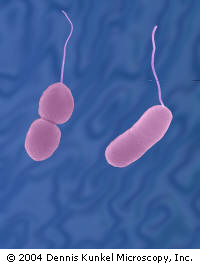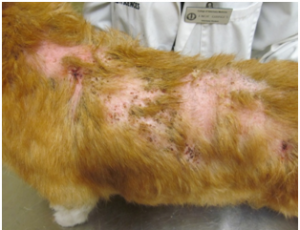Hello my name is Vibrio parahaemolyticus and I am a Gammaproteobacteria of the Vibrio genus. I have a curved rod-like figure and a single flagellum for getting around. I always wear my gram negative coat to protect me against all the nasty things out there that would harm me. I prefer hanging out at places where oxygen is present but I can do just fine even without it. In the presence of oxygen I can use my magical oxidase enzyme to help me grow faster. For those reasons humans label me as a facultative anaerobe. I’m not a picky eater, although my favorite food is glucose I have no problems eating galactose when glucose is not available. However, I refuse to eat that disgusting stuff called sucrose.
I prefer moist salty water so I’m usually found near coastal waters. I make my home in the many friendly sea creatures there especially the comfy shellfish. I am usually content in my home but from time to time I like to travel to exotic locations. The most popular destination is in the human gastrointestinal tract where I can get around freely, host many parties, and make many new friends. You can tell I’m having a blast when you experience diarrhea, vomiting, cramps and pain. Humans refer to this a gastroenteritis and it is recommended that you drink plenty of water when that happens (helps with all the alcohol too!). Of course, I am also a generous host. My ability to host such wonderful parties is due to my virulent Type III Secretion System. Using this system I can inject my “thermostable direct hemolysin” party favors directly into my guest’s cytoplasm! Friendly cells who come in contact with me will explode with joy. You can see my party favors at work by putting me on a blood agar plate and observing the β-hemolytic activity.
I come from the large family of the Vibrio genus. My family also have curved rod-like figures and wear gram negative coats. Like me, my family prefers salty water and produce oxidase for aerobic metabolism. My most famous sibling is Vibrio cholerae who is known to cause cholera. Others in my family, like Vibrio anguillarum can cause vibriosis while Vibrio fluvialis can cause diarrhea. The Vibrio family comes from a long line of Gammaproteobacteria. This includes the orders of Enterobacteriales, Legionellales, Pseudomonadales and many more.
I was in the news recently for throwing awesome parties in 104 humans spanning 13 different states in a period of five months in 2013. Every year I throw parties in as many as 35,000 humans and make many times that in cellular friends! To all my human fans out there, don’t be shy and invite me in for great parties in your tummy! Below is a photo of me so you could admire my curves. Feel free to drop by sometime and invite me over. I’ll stock up on party favors and look forward some fun times!
References:
[1] Tortora, Gerard J., et al. Microbiology An Introduction 11th edition. Pearson Education, Inc. 2013.
[2] Microbiology Laboratory. McGraw-Hill Education. 2014.
[3] “Vibrio_parahaemolyticus.” Wikipedia: The Free Encyclopedia. Wikimedia Foundation, Inc. 22 July 2004. <http://en.wikipedia.org/wiki/Vibrio_parahaemolyticus>
[4] ” Identification of Vibrio parahaemolyticus Strains at the Species Level by PCR Targeted to the toxR Gene.” Centers for Disease Control and Prevention. 2010. <http://www.cdc.gov/vibrio/vibriop.html>
[5] “Improved Method for Detection of Vibrio parahaemolyticus in Seafood.” US National Library of Medicine: National Institute of Health. 2001. <http://www.ncbi.nlm.nih.gov/pmc/articles/PMC93376/>
[6] “Beta-galactosidase.” Wikipedia: The Free Encyclopedia. Wikimedia Foundation, Inc. 22 July 2004. <http://en.wikipedia.org/wiki/Beta-galactosidase>
[7] “104 sickened: increase in Vibrio parahaemolyticus infections associated with consumption of Atlantic coast shellfish — 2013.” 18 April 2014 <http://barfblog.com/2014/04/104-sickened-increase-in-vibrio-parahaemolyticus-infections-associated-with-consumption-of-atlantic-coast-shellfish-2013/>
Images:
http://www.ehagroup.com/resources/pathogens/vibrio-parahaemolyticus/






